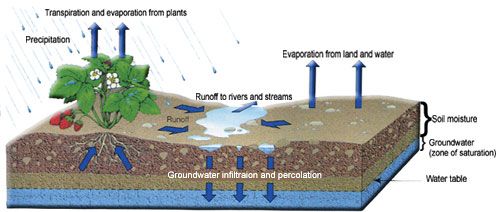Study of World’s Groundwater Depletion
Published on by Water Network Research, Official research team of The Water Network in Academic
Human consumption could deplete groundwater in parts of India, southern Europe and the U.S. in the coming decades, according to new research presented here today.
 New modeling of the world's groundwater levels finds aquifers—the soil or porous rocks that hold groundwater—in the Upper Ganges Basin area of India, southern Spain and Italy could be depleted between 2040 and 2060.
New modeling of the world's groundwater levels finds aquifers—the soil or porous rocks that hold groundwater—in the Upper Ganges Basin area of India, southern Spain and Italy could be depleted between 2040 and 2060.
By 2050, as many as 1.8 billion people could live in areas where groundwater levels are fully or nearly depleted because of excessive pumping of groundwater for drinking and agriculture, according to Inge de Graaf, a hydrologist at the Colorado School of Mines in Golden, Colorado.
"While many aquifers remain productive, economically exploitable groundwater is already unattainable or will become so in the near future, especially in intensively irrigated areas in the drier regions of the world," said de Graaf.
Knowing the limits of groundwater resources is imperative, as billions of gallons of groundwater are used daily for agriculture and drinking water worldwide, said de Graaf.
Previous studies used satellite data to show that several of the world's largest aquifers were nearing depletion. But this method can't be used to measure aquifer depletion on a smaller, regional scale, according to de Graaf.
In the new research, de Graaf and colleagues from Utrecht University in the Netherlands used new data on aquifer structure, water withdrawals, and interactions between groundwater and surrounding water to simulate groundwater depletion and recovery on a regional scale.
The research team used their model to forecast when and where aquifers around the world may reach their limits, or when water levels drop below the reach of modern pumps. Limits were considered "exceeded" when groundwater levels dropped below the pumping threshold for two consecutive years.
The new study finds heavily irrigated regions in drier climates, such as the U.S. High Plains, the Indus and Ganges basins, and portions of Argentina and Australia, face the greatest threat of depletion.
Although the new study estimates the limits of global groundwater on a regional scale, scientists still lack complete data about aquifer structure and storage capacity to say exactly how much groundwater remains in individual aquifers, she said.
Source: Phys.org
Media
Taxonomy
- Water
- Modeling
- Groundwater
- Aquifer
- Groundwater Recharge
- Groundwater Modeling
- Groundwater Mapping
- Groundwater Resource
1 Comment
-
Like climate chance also land grabing seems hardly to stop. More precise measuring of falling Hydrologically is desirable, but in any case we know that in the aquifer more water is used than delivered. Stopping the wateruse is one end of stopping the process. Providing more water to the subsoil is the other way to go; even better both ways. Justdiggit works (https://justdiggit.org) on sustainable regreening in large scale desertified areas in order to reduce erosion and high floods, increase green production and groundwaterflow and moderate climate extreems. Wageningen University provides scientific basis to this 'Hydrologic Corridor' concept. We choose her for slowing down the hydrological cycle.